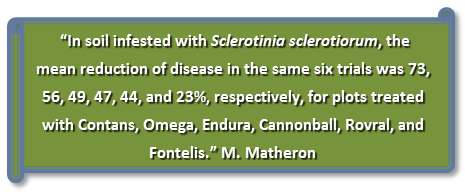
Successful management of any plant disease is achieved by targeting one or more
vulnerable stages in the disease development cycle. For Sclerotinia drop of lettuce,
caused by the fungi Sclerotinia minor and S. sclerotiorum, this point of attack
centers on the fungal bodies called sclerotia. At crop maturity, sclerotia produced
on infected plants will be incorporated into soil along with crop debris as the
land is prepared for planting the next crop. For the Sclerotinia fungi, sclerotia
serve the same purpose that seeds do for plants; that is, they allow the organism
to carry over in soil in a dormant state until conditions become favorable for their
germination and growth. Over the past several years of fungicide evaluation trials,
the traditional fungicide application to the lettuce bed surface beginning after
thinning has provided at best about a 50 to 60% reduction in dead plants compared
to plots not receiving a fungicide treatment. In a 6-year comparison of fungicide
efficacy in plots containing Sclerotinia minor, the average reduction of disease
was 61, 53, 44, 43, 43, and 38%, respectively, for plots treated with fluazinam
(Omega), boscalid (Endura), iprodione (Rovral), penthiopyrad (Fontelis), Coniothyrium
minitans (Contans), and fludioxonil (Cannonball). In soil infested with Sclerotinia
sclerotiorum, the mean reduction of disease in the same six trials was 73, 56, 49,
47, 44, and 23%, respectively, for plots treated with Contans, Omega, Endura, Cannonball,
Rovral, and Fontelis. Application of fungicides to the bed surface prevents germination
of sclerotia at or near the soil surface, thus reducing the incidence of Sclerotinia
drop. Ongoing research is focused on examining new active ingredients and methods
of application to soil with the goal of consistently increasing the degree of Sclerotinia
drop control above levels now achieved.
Click picture to listen to Mike's update

To contact Mike Matheron go to: matheron@ag.arizona.edu.



